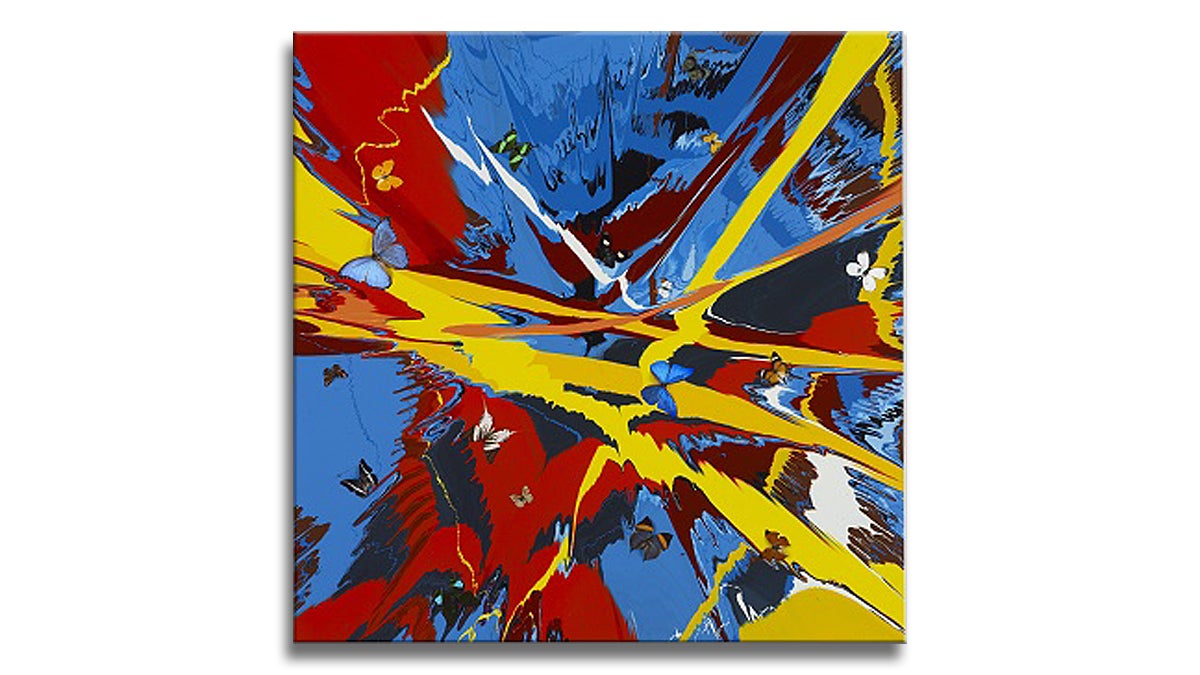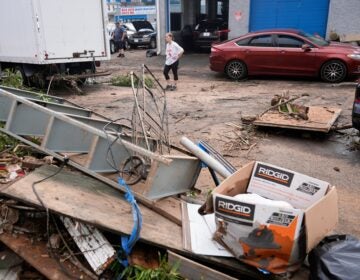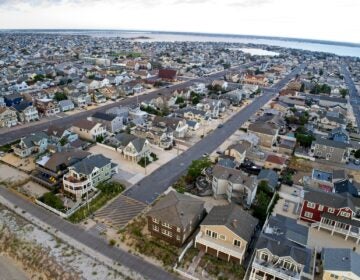Princeton exhibit looks at innovative uses of materials in art

Damien Hirst
“Objects of every sort are materials for the new art: paint, chairs, food, electric and neon lights. Smoke, water, old socks, a dog, movies, a thousand other things that will be discovered by the present generation of artists.”
These words were spoken almost 60 years ago by Alan Kaprow, the performance artist and one-time Rutgers faculty member who helped create the Fluxus movement. Artists continue to expand the types of materials in the work they do today.
As its title implies, A Material Legacy: The Nancy A. Nasher and David J. Haemisegger Collection of Contemporary Art, on view at the Princeton University Art Museum through Oct. 30, 2016, explores the innovative use of materials by artists.
These are some of the largest works of contemporary art, by artists with similarly large reputations, to have entered the art museum’s space. The 35 large-scale works by the likes of Edmund de Waal, Mark di Suvero, Katharina Grosse, Damien Hirst, Anish Kapoor, Matthew Ritchie, Julian Schnabel, Richard Serra, Ursula von Rydingsvard, Kara Walker and Kehinde Wiley, among others,offer a look at the varied practices of art making over the last decade. How does a simple drawing convey an experience, compared with a monumental sculpture? What are the material challenges artists face as they work on a monumental scale?
“Artists are using materials in extraordinary varied ways,” said Nancy A. Nasher-David J. Haemisegger Director James Steward (yes, those are the same Nasher and Haemisegger from whose collection the exhibition comes—more on that later). “…the possibilities for manipulating materials through technologies in printing or metalworking… didn’t exist 100 years ago. And scale—indeed, scale is one of the things that strikes me most about the exhibition—that artists are pushing the limits of scale in terms of the sizes of their canvases or the weight and density of their sculptures. Many of these are works that artists made with public space and public viewing in mind. And certainly they are working at a scale that tests the limits of our galleries!”
Edmund de Waal’s “Breathturn, I,” for example, consisting of 476 diminutive, precious porcelain vessels in an aluminum and Plexiglas cabinet, might fit nicely on a dining room wall. An artist and author (“The Hare with the Amber Eyes,” “The White Road”), de Waal throws pots for the same reason he writes—to tell stories of collecting, ownership and loss. “Pots turn into words and words turn into pots,” he says. By placing hand-thrown ceramic vessels on a metal display case, de Waal calls attention to the strong human impulse to collect things, illustrating how objects accumulate individual biographies along the way. Each vessel bears the handprint of the artist.
In his monumental work, “eyes that run like leaping fire,” Elliott Hundley uses a plethora of materials—photographs, magazine clippings, straight pins, sequins, letters—behind a veil of hanging red threads. The installation meditates on Euripedes classic Greek tragedy “The Bacchae” in which a mother unknowingly kills her son during a ritual.
Nasher and Haemisegger, Princeton University Class of 1976, met while students. “I believe they met on their first day at Princeton,” recounted Steward.
The couple has continued a family tradition, amassing a significant collection of contemporary art. They are the daughter and son-in-law of Raymond D. and Patsy T. Nasher, art collectors, patrons, benefactors and philanthropists. While Raymond and Patsy assembled one of the world’s great collections of modern sculpture, largely housed in the Nasher Sculpture Center in Dallas, Nancy and David have mostly focused on contemporary art, including painting, sculpture, drawing and multimedia works.
“Nancy in particular grew up surrounded by art,” said Steward. “As a young woman, Nancy was painted by Andy Warhol—so I think it’s fair to say that art is in her veins.”
Nasher and Haemisegger continue to play important roles at PUAM, where she is a member of the museum’s Advisory Council. “Both have shared with me that it is art that unites them in their love of Princeton,” continues Steward, “and so it’s natural that they have both become involved in and supportive of this museum’s work. They endowed the directorship understanding how that would continue strengthening the museum’s financial health and signal our growing maturity as a museum.”
“Patsy and Ray Nasher were interested in putting art in public spaces, where the public could see and engage with it,” says Heather N. Cammarata-Seale, curatorial associate. “Now Nancy and David are taking the lead with their collection so people can enjoy and engage with it.”
Cammarata-Seale looked at the historical, cultural and ethical implications of taxidermy as an artistic medium for her doctoral thesis at Rutgers, where she focused on modern contemporary art. The use of taxidermy in art practice intrigued her because she loves animals, and cares for two rescue puppies. So, for example, Damien Hirst’s 1991 shark in formaldehyde, “The Physical Impossibility of Death in the Mind of Someone Living,” is something she’s considered.
Perhaps the shark is Hirst’s material legacy, but here, in “Beautiful Superheroes Painting (with Butterflies),” he creates what Cammarata-Seale describes as a gestural abstract made with spin art technology. Embedded within the swirls of paint are actual butterfly wings*, exemplifying the confluence of art and nature theme.
“Since antiquity, artists have been innovating with materials, and the avant-garde artists broke away from the traditions,” Cammarata-Seale says. “This exhibition continues that exploration. Hirst is experimenting with his personal oeuvre, letting chance play a part.”
*Were any animals harmed in the creation of Hirst’s work with butterflies? Cammarata-Seale cannot say, but a 2012 report in The Telegraph claimed that 9,000 butterflies were sacrificed for a Hirst retrospective at the Tate Modern in London.
________________________________________________________
The Artful Blogger is written by Ilene Dube and offers a look inside the art world of the greater Princeton area. Ilene Dube is an award-winning arts writer and editor, as well as an artist, curator and activist for the arts.
WHYY is your source for fact-based, in-depth journalism and information. As a nonprofit organization, we rely on financial support from readers like you. Please give today.





